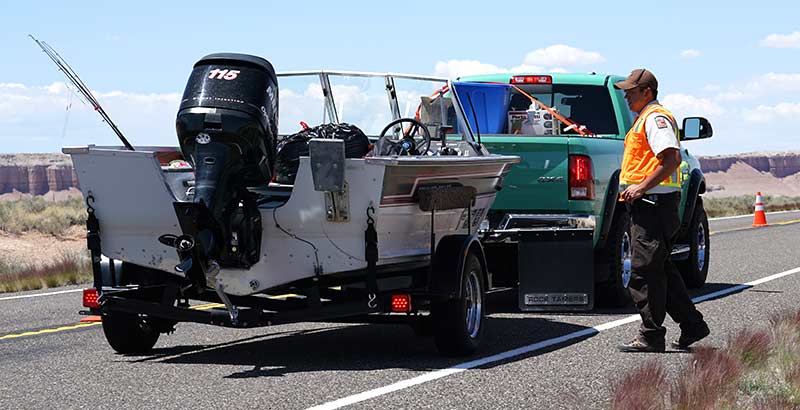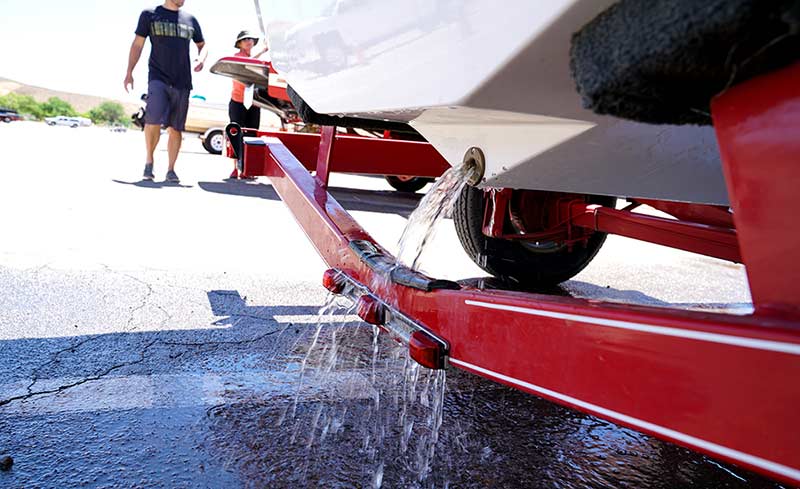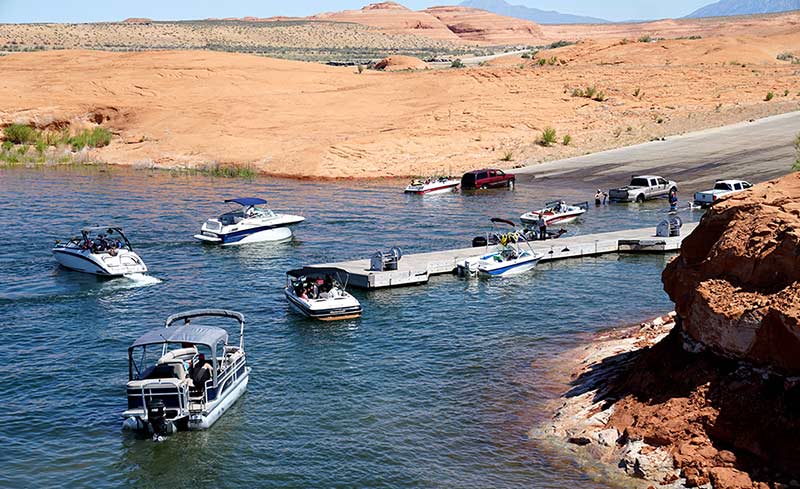What to expect when boating at Lake Powell
Invasive mussels threaten ecosystems and fisheries.
By Morgan Jacobsen
DWR Southeast Region outreach manager
FOR CENTURIES, the notion of a stowaway has been almost universally disliked. It's changed the way we secure maritime vessels and airports. It's caused the spread of noxious weeds that threaten agricultural practices and wildfire-prone landscapes. Perhaps it's crossed your mind in less catastrophic ways, such as catching a cold at a family party or bed bugs at a questionable motel.

Quagga mussel laws at Lake Powell have been in place for several years. Boaters who do not to follow them could face significant fines.
The laws for quagga mussel containment at Lake Powell have been in place for several years, and boaters who choose not to follow them could face significant fines.
In every case, such passengers make their way by finding concealed transit at the expense of people and, at times, precious resources. Utah's aquatic resources are at risk today from two especially pernicious stowaways: invasive quagga and zebra mussels. Tiny as they are, these mussels threaten to clog and choke out delicate ecosystems and renowned fisheries, as well as agricultural and residential water infrastructure, costing taxpayers millions of dollars.
What are the rules?
These rules apply to all watercraft — ski boats, jet skis, canoes, paddleboards, float tubes and others — and it is each recreationist's responsibility to know them. So if you plan on recreating at Lake Powell — which we hope you do — here are the steps you should take to save time, protect your boat and protect the waters you enjoy:
- No inspection is required before launching. But please ensure that your watercraft is still cleaned, drained and dry prior to launching.
- After retrieving your watercraft from the lake, clean all plants, animals and mud from your boat, trailer and equipment. Then proceed immediately to an inspection station for a mandatory inspection. Be prepared for wait times of an hour or more during times of high volume. As long as these stations are operating, which is usually during daylight hours, you are required to stop.
- At Bullfrog Marina, the station is located at the Lot D parking lot.
- At Wahweap, the station is located at the top of the boat ramp and at other nearby locations.
- At Halls Crossing, the station is located at the top of the boat ramp.
- A technician will conduct a brief interview with you, inspect your watercraft and help you fill out some paperwork. They'll ask how long you were on the water, where you're headed next and how soon.
- Utah's required dry times after boating at Lake Powell are seven days in summer, 18 days in fall and spring, or 30 days in winter. If your next boating trip to another waterbody will be after those dry times, you'll only need an inspection. If you plan on boating elsewhere sooner than those dry times, you'll need a full decontamination. Both services are free at the check stations.
— Inspections include draining water completely from all spaces in the vessel and a visual check for attached mussels on the boat, trailer and equipment.
— Decontaminations include flushing the engine system, hull, anchor, trailer and all personal equipment that got wet with hot water. All spaces containing water are then drained.
— If mussels are found attached to your property, you'll be referred to a private decontamination company. Private companies may assess a fee for these services at the watercraft owner's expense.
- All boaters must remove the drain plug and keep it out while they travel.
- Everyone that passes through the station will receive a seal attached to their boat and trailer indicating whether they can launch elsewhere immediately or after a dry time. Corresponding information is also provided on a receipt. Keep this documentation with you until your next launch as law enforcement personnel may ask for it.
The bigger picture
On Memorial Day, conservation officers with the Utah Division of Wildlife Resources set up a checkpoint just south of Hanksville. They checked 247 boats for the necessary seal and paperwork. Fifty-eight boats — almost 25 percent — didn't have a seal or receipt, indicating the owners illegally skipped the inspection. Many of them were cited.
It's a discouraging figure given that only one boat, one sample of contaminated water, one stowaway mussel could infest an entire water system.
"It's worrisome for the rest of the state," said Lt. Ben Wolford, who supervised the checkpoint.
But among the other 75 percent, many boaters are getting the bigger picture. They know that prevention is the best way to keep Utah's waters healthy. Many feel that Clean, Drain and Dry is just part of taking proper care of their boat.
Cache County resident Paul Clark takes his boat to Hyrum Dam twice a week, as well as Bear Lake, Flaming Gorge, Willard Bay and Lake Powell several times a year. For him, getting an inspection when leaving Lake Powell is just like checking the air in his tires or getting an oil change.
"It's just part of owning a boat now. It's part of the world we live in," Clark told me while his boat was inspected at Bullfrog Marina. "If I found out I was the one that spread the mussels to a lake because of my ignorance or my lack of patience, that's tough to live with."
For more information on invasive mussel containment efforts at Lake Powell, visit STDoftheSea.com, or contact interdiction specialists John Steffan at 435-299-9562 or Julie Sabattis at 435-592-9723.

















